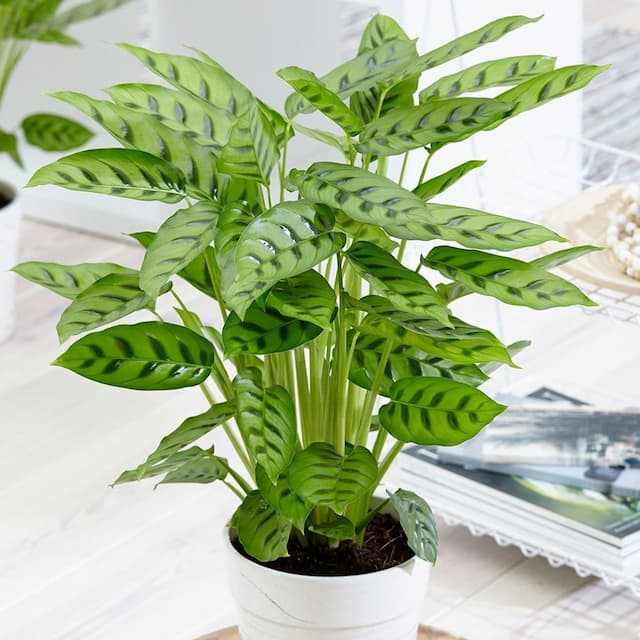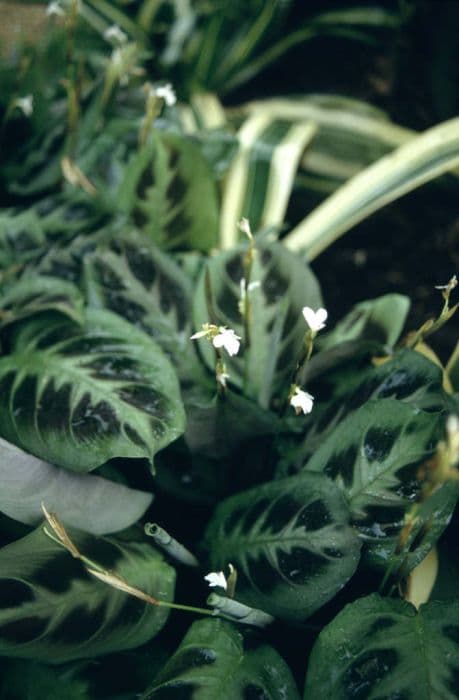Eternal Flame Goeppertia crocata

ABOUT
The plant commonly known as the Eternal Flame due to its vibrant flame-like flowers, presents a striking appearance. Its foliage is characterized by lush green leaves with an elongated oval shape featuring pointed tips. The leaves' surface is glossy and often has a leathery texture, which gives the plant a robust and vigorous look. Running through these leaves are distinctive venation patterns that are slightly raised, adding depth and interest to their overall aesthetic. The most captivating aspect is the contrast created by its vivid orange flowers, which emerge from the center of the plant. These blooms are what resemble a small, eternal flame, hence the plant's common name. The blooms are composed of a central spadix surrounded by bract-like structures that have a waxy, shiny surface and a fiery hue. Collectively, this blending of rich green foliage and the bright burst of floral color provides a tropical and exotic charm, making it popular for adding a splash of vibrancy to indoor spaces.
About this plant
 Names
NamesFamily
Marantaceae.
Synonyms
Eternal Flame, Tassle Flower, Brazilian Flame.
Common names
Calathea crocata, Phrynium crocatum, Maranta crocata.
 Toxicity
ToxicityTo humans
The plant commonly known as the Eternal Flame is not considered toxic to humans. Therefore, there are no known symptoms associated with poisoning from the ingestion of this plant because it is not poisonous. As a result, ingesting parts of the Eternal Flame is not expected to have harmful consequences for humans.
To pets
The Eternal Flame is also not considered toxic to pets. Because it is not poisonous, there are no expected symptoms of poisoning if your pet ingests parts of this plant. Thus, ingestion of the Eternal Flame is not likely to result in any adverse effects for pets.
 Characteristics
CharacteristicsLife cycle
Perennials
Foliage type
Evergreen
Color of leaves
Mixed
Height
2-3 feet (60-90 cm)
Spread
2-3 feet (60-90 cm)
Plant type
Herb
Hardiness zones
11
Native area
Brazil
Benefits
 General Benefits
General Benefits- Aesthetic Appeal: Goeppertia crocata, commonly known as Eternal Flame, has striking orange blooms and lush foliage that enhance the visual appeal of any space.
- Low Maintenance: Eternal Flame plants are relatively easy to care for, requiring minimal attention to thrive indoors.
- Humidity Tolerance: This plant can tolerate higher humidity levels, which makes it suitable for bathrooms and kitchens.
- Shade Tolerance: Eternal Flame can grow in low light conditions, making it an ideal plant for less sunny spaces in the home or office.
- Mood Booster: The vibrant flowers and green leaves of Eternal Flame can uplift the mood and create a more pleasant living or working environment.
- Long Blooming: The plant often has a long blooming period, which can provide color and interest to an indoor space for an extended time.
 Medical Properties
Medical PropertiesThis plant is not used for medical purposes.
 Air-purifying Qualities
Air-purifying QualitiesThis plant is not specifically known for air purifying qualities.
 Other Uses
Other Uses- Artistic Inspiration: The striking foliage of the Goeppertia crocata, commonly known as the Eternal Flame, can serve as an inspiration for artists and designers looking to incorporate natural patterns and vibrant colors into their work.
- Educational Tool: This plant can be used in botanical studies and educational programs to teach about plant care, tropical ecosystems, and the biodiversity of houseplants.
- Photography Subject: The Eternal Flame's unique orange blooms make it a popular subject for photographers and social media influencers who want to add a pop of color to their imagery.
- Color Dye: Although not commonly used for this purpose, the vibrantly colored flowers of the Eternal Flame could potentially be explored for natural dye extraction.
- Feng Shui: In Feng Shui, the Eternal Flame plant could be positioned in a home or office to add a fire element, symbolizing energy and passion.
- Gifting: Due to its long-lasting flowers and elegance, the Eternal Flame plant is often given as a gift for celebrations such as housewarmings and anniversaries.
- Event Decor: This plant can be used to aesthetically enhance the decor at events like weddings or parties, especially when a tropical or exotic theme is desired.
- Crafts: The leaves and flowers can be used in dried floral arrangements or as elements in handmade paper crafts and scrapbooking.
- Horticultural Shows: Goeppertia crocata can be featured in horticultural shows and competitions for its unique appearance and the challenge it presents for growers to maintain its vibrant coloring.
- Literary Symbolism: Writers may use the Eternal Flame plant as a literary symbol to represent enduring passion or as a metaphor in storytelling due to its persistent blooms.
Interesting Facts
 Feng Shui
Feng ShuiThe Eternal Flame Plant is not used in Feng Shui practice.
 Zodiac Sign Compitability
Zodiac Sign CompitabilityThe Eternal Flame Plant is not used in astrology practice.
 Plant Symbolism
Plant Symbolism- Rarity - Goeppertia crocata, commonly known as the Eternal Flame due to its orange-red inflorescences, is a rare plant, which makes it symbolic for unique and rare beauty.
- Warmth - The vibrant, warm-colored blooms inspire a sense of comfort and warmth, symbolizing hospitality and a welcoming nature.
- Celebration - The fiery appearance of the Eternal Flame's flowers is often associated with festivities, making it a symbol of celebration and joy.
- Eternal Life - The common name 'Eternal Flame' suggests a connection to undying or everlasting life, offering a symbolic meaning of immortality or remembrance.
 Water
WaterEternal flame plant (Goeppertia crocata) prefers to be kept moist but not soaking wet. It is crucial to water this plant when the top inch of soil feels dry to the touch, which typically means watering approximately once a week. The amount of water needed can vary based on environmental conditions, but generally, watering with around 16 ounces of water weekly is sufficient. During the winter months, reduce watering frequency to prevent root rot. Always use room temperature water and ensure the pot has adequate drainage.
 Light
LightThe eternal flame plant prefers bright, indirect sunlight. It thrives under the cover of a sheer curtain or in a north-facing window where it can receive plenty of light without being exposed to harsh direct rays. Avoid placing the plant in full sun, as this can cause the leaves to fade or burn.
 Temperature
TemperatureThe eternal flame plant thrives in temperatures ranging from 65 to 75 degrees Fahrenheit. It should not be exposed to temperatures below 60 degrees Fahrenheit or above 80 degrees Fahrenheit for prolonged periods. Keep this plant away from drafts, air conditioners, and heating vents to avoid extreme temperature fluctuations.
 Pruning
PruningPruning the eternal flame plant is necessary to maintain its appearance and health. Remove brown or yellow leaves at the base to encourage new growth. Pruning is best done in spring or early summer, but can be performed year-round as needed. This plant rarely requires heavy pruning; simply tidy it up to keep it looking its best.
 Cleaning
CleaningAs needed
 Soil
SoilThe best soil mix for the Eternal Flame plant (Goeppertia crocata) is a well-draining, peat-based potting soil with added perlite or coarse sand to improve aeration. Aim for a soil pH between 6.0 and 6.5.
 Repotting
RepottingThe Eternal Flame plant should be repotted every two to three years or when it becomes too large for its current pot.
 Humidity & Misting
Humidity & MistingThe Eternal Flame plant thrives in high humidity conditions, preferably between 60-80%.
 Suitable locations
Suitable locationsIndoor
Place in bright, indirect light and keep the soil moist.
Outdoor
Shelter from direct sun; mist regularly for humidity.
Hardiness zone
10-11 USDA
 Life cycle
Life cycleGoeppertia crocata, commonly known as the Eternal Flame Plant, begins its life cycle as a seed which germinates in warm, moist soil, emerging as a small seedling with characteristic patterned foliage. The seedling grows by producing larger leaves and stems, effectively establishing itself as a juvenile plant. As it matures, the Eternal Flame Plant develops a stronger stem and a larger, more robust root system. It reaches full maturity when it begins to produce its striking, orange-red inflorescences that resemble flames, hence giving it its common name. After flowering, if pollinated, it may produce seeds that can be dispersed to create new plants. Throughout its life, Goeppertia crocata undergoes periodic leaf shed and regrowth, maintaining the lifecycle through vegetative propagation when offsets form at its base.
 Propogation
PropogationPropogation time
Spring-Early Summer
Propogation: The most popular method of propagation for the Goeppertia crocata, commonly known as the Eternal Flame Plant, is through division. This is best done during the spring when the plant is entering its active growing phase. To propagate by division, gently remove the plant from its pot and separate the rhizomes, ensuring that each division has at least one growing point or shoot. These divisions can then be repotted in a well-draining soil mix, with each new pot being watered thoroughly. It's important to maintain a warm and humid environment to encourage root development, placing the new pots in indirect sunlight until new growth appears, signaling successful propagation.









